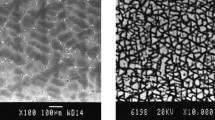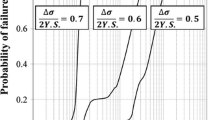Abstract
Fully reversed strain controlled LCF tests were performed on 4.5 mm thick sheet specimens IN-617 at 1033 K and 1144 K in air. The strain-life and cyclic stress-strain data were analyzed parametrically. While the inelastic strain amplitude-life relationships are similar at the two temperatures, the softer cyclic stress-strain relationship observed at 1144 K produces inferior fatigue resistance to that at 1033 K when comparisons are based on stress or total strain amplitude. Transmission electron microscope observations suggest that grain boundary sliding was the primary mechanism of deformation at 1144 K while at 1033 K intragranular slip produced a dense dislocation substructure which was stabilized by fine scale precipitation of M23C6. At 1144 K, grain boundary migration occurred within the specimen interiors, producing a cellular precipitation of M23C6 as well as the intragranular M23C6 observed at 1033 K. Cellular precipitation was not observed in the near surface regions. This is attributed to oxygen penetration along grain boundaries. Comparison of the data with mean stress-HCF data indicates that the mean load significantly reduces fatigue resistance at both temperatures.
Similar content being viewed by others
References
J. K.Tien and S. M. Copley:Aetall. Trans., 1971,vol. 2, pp. 215–19.
D. A. Woodford: inEngineering Aspects of Creep, Inst. Mech. Eng. (London), 1980, pp. 55–60.
R.H. Bricknell and D.A. Woodford:Metall. Trans. A, 1981, vol. 12A, pp. 425–33.
Inconel 617 Data Sheet, Huntington Alloys, Huntington, WV, 1979.
W.L. Mankins, J.C. Hosier, and T.H. Bassford:Metall. Trans., 1974, vol. 5, pp. 2579–90.
T. Hirano, M. Okada, H. Araki, T. Noda, H. Yoshida, and R. Watanabe:Metall. Trans. A, 1981, vol. 12A, pp. 451–58.
T. Slot, R.H. Stentz, and J.T. Berling: inManual on Low Cycle Fatigue Testing, ASTM STP 465, ASTM, Philadelphia, PA, 1969, pp. 100–28.
M. R. Mitchell: inFatigue and Microstructure, M. Meshii, ed., ASM, Metals Park, OH, 1979, pp. 385–437.
L.F. Coffin:Trans. ASME, 1954, vol. 76, pp. 931–37.
S. S. Manson: NASA Tech. Note 2933, NASA LERC, 1954.
S.S. Manson: NASA Report NASA-TX-52084, 1965.
T. P. Sherlock: Westinghouse Combustion Turbine Systems Division, Concordville, PA, private communication, 1980.
E.P. Butler and D. Williams:Int. Met. Rev., 1981, vol. 26, pp. 153–83.
J. M. Oblak and W. A. Owczarski:Trans. TMS-AIME, 1968, vol. 242, pp. 1563–67.
S. Kihara, J. B. Newkirk, A. Ohtomo, and Y. Saiza:Metall. Trans. A, 1980, vol. 11A, pp. 1019–31.
Author information
Authors and Affiliations
Rights and permissions
About this article
Cite this article
Burke, M.A., Beck, C.G. The high temperature low cycle fatigue behavior of the nickel base alloy IN-617. Metall Trans A 15, 661–670 (1984). https://doi.org/10.1007/BF02644197
Received:
Issue Date:
DOI: https://doi.org/10.1007/BF02644197




